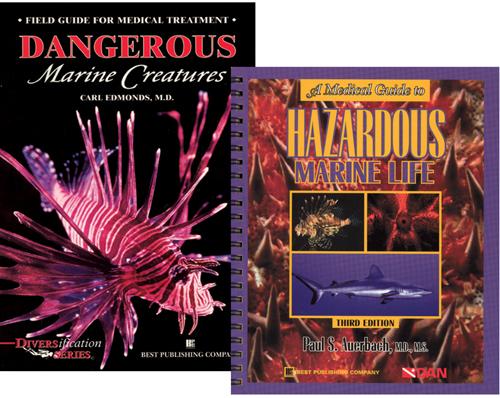Holiday Customer Support Closure
Please note that our customer support will be closed for the holidays starting December 24th through January 4th.
DEPTH Blog
Lobster and Lionfish
Today marks the start of the annual two-day spiny lobster sport season in Florida, known as "mini-season," and it got us thinking (about more than just dinner) . . .
This year, the Florida Fish and Wildlife Conservation Commission (FWC) is allowing divers who harvest 10 or more lionfish per day to harvest one additional spiny lobster during the mini-season. Why? The FWC states that, "Lionfish are invasive species that have a potential negative impact on Florida’s native wildlife and habitat. With no predators or other mechanisms such as disease or parasites keeping the lionfish population under control in Florida at this time, harvest by divers is the primary means of lionfish removal. If the program is successful at encouraging lionfish removal, it could be continued in future years." (source: http://myfwc.com/news/news-releases/2015/june/25/lionfish-lobster/)
So whether you're participating in lionfish harvesting during mini-season, or as part of another dive, the following offers a few tips to avoid and treat injury.
What to Avoid
The spines on a lionfish will become erect is the animal is alerted, threatened, or touched. The single dorsal fin may contain 11-17 spines. The spines are covered by an integumentary sheath, which is pierced and displaced when contact is made with the victim's skin. There are also spines on the pectoral and anal fins. Venom then passes along the spine, which may be grooved or hollow, into the wound.
The intensity of the sting depends on the size of the fish, the number of spines penetrating the skin, and other factors. There is a variable number of spines.
Symptoms Following Injury
The puncture wound or wounds become numb, but the surrounding area hypersensitive. Paralysis of the surrounding muscles is common. Around the puncture wound there is a red inflamed and sometimes bluish zone. Surrounding this is an area which is pale and swollen, developing within half an hour. The swelling is made worse by activity and lessened by elevation of the injured area.
The patient is often very distressed by the degree of pain, and this distress can merge into a delirious state.
Generalized weakness may develop into paralysis and even involve the cranial nerves, affecting facial muscles, vision, and speech. Malaise, nausea, vomiting, and sweating may be associated with high temperature and changes in the blood. Respiratory distress may develop in severe cases.
After recovery from the acute phase of a serious fish sting, neuropsychological symptoms are not uncommon, and may last between days and months. Symptoms include anxiety, apathy, weakness, impaired concentration, insomnia and depression.
First Aid
- The patient shoudl be laid down and reassured. If the spine or integument is still present, it should be gently extracted. A little bleeding may help remove some venom. Surface venom is removed by washing the area with water. The patient's state may become far more serious than it first appears. Copius bleeding (rare) should be stopped.
- The affected area should be rested in an elevated position. Arrangements can then be made to immerse the wound in hot (up to 45 degrees C, 113 degrees F) water for 30-90 minutes - or until the pain no long recurs. If the area cannot be immersed, as on the head or body, hot packs may be applied. The duration of the hot water immersion depends on the symptoms. If the site of the injury is removed from the water and the pain recurs, it should be re-immersed.
- Local variations are often promoted by different groups. Some claim that other fluids are more beneficial than water, including vinegar, oils, and gasoline. Water is more readily available, effective, and less explosive. Hot water may be obtained from the radiators of engines, diluting the coffee from thermos flasks, etc. Seawater can be used.
- The wound should be washed and cleaned, after the heat treatment is no longer required. Following pain relief, the limb should be immobilized in an elevated position, and covered with a clean dressing, for example, an unused newspaper.
Warning: Read the above carefully. One unfortunate Australian fisherman lost the top of his finger because of the treatment. His injured finger was first anaesthetised by local anaesthetic and THEN immersed in very hot water. The anaesthetic worked well - he did not feel his finger cooking.
Reference: Edmonds, Carl, M.D. Field Guide for Medical Treatment; Dangerous Marine Creatures. Flagstaff, AZ: Best Publishing Company: 1995.
Get More Free Diving Resources!
Enter Your Name and Email Below to Get More Free Resources for Divers!
Recommended Reading
These two field guides teach you everything you need to know about the most common dangerous marine creatures, including descriptions and photos, the various ways in which they can inflict harm, how to recognize an injury (symptoms, visual signs, and real-life case studies), and how to treat an injury in the field.
These field guides will immediately become your most valuable resources on marine life for any and all aquatic adventures.
 |
Get both for only $29.99! A Value Of $60! |
When you subscribe to the blog, we will send you an e-mail when there are new updates on the site so you wouldn't miss them.







